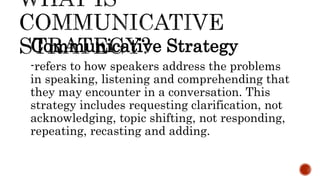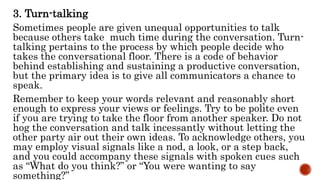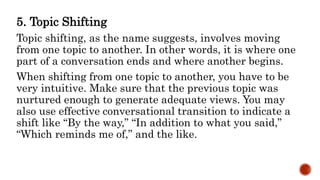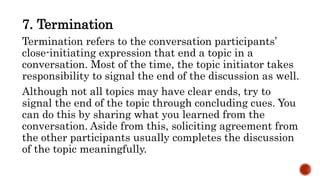Presentation-oral.com.pptx
- 2. Communicative Strategy -refers to how speakers address the problems in speaking, listening and comprehending that they may encounter in a conversation. This strategy includes requesting clarification, not acknowledging, topic shifting, not responding, repeating, recasting and adding.
- 3. 1. Nomination A speaker carries out nomination to collaboratively and productively establish a topic. Basically, when you employ this strategy, you try to open a topic with the people you are talking to. When beginning a topic in a conversation, especially if it does not arise from a previous topic, you may start off with news inquiries and news announcement as they promise extended talk. Most importantly, keep the conversational environment open for opinions until the prior topic shuts down easily and initiates a smooth end. This could efficiently signal the beginning of a new topic in the conversation.
- 4. 2. Restriction Restriction in communication refers to any limitation you may have as a speaker. When communicating in the classroom, in a meeting, or while hanging out with your friends, you are typically given specific instructions that you must follow. These instructions confine you as a speaker and limit what you can say. For example, in your class, you might be asked by your teacher to brainstorm on peer pressure or deliver a speech digital natives. In these cases, you cannot decide to talk about something else. On the other hand, conversing with your friends during ordinary days can be far more casual than these examples. Just the same, remember to always be on point and avoid sideswiping from the topic during the conversation to avoid communication breakdown.
- 5. 3. Turn-talking Sometimes people are given unequal opportunities to talk because others take much time during the conversation. Turn- talking pertains to the process by which people decide who takes the conversational floor. There is a code of behavior behind establishing and sustaining a productive conversation, but the primary idea is to give all communicators a chance to speak. Remember to keep your words relevant and reasonably short enough to express your views or feelings. Try to be polite even if you are trying to take the floor from another speaker. Do not hog the conversation and talk incessantly without letting the other party air out their own ideas. To acknowledge others, you may employ visual signals like a nod, a look, or a step back, and you could accompany these signals with spoken cues such as “What do you think?” or “You were wanting to say something?”
- 6. 4. Topic Control Topic control covers how procedural formality or informality affects the development of topic in conversations. For example, in meetings, you may only have a turn to speak after the chairperson directs you to do so. Contrast this with a casual conversation with friends over lunch or coffee where you may take the conversational floor anytime. Remember that regardless of the formality of the context, topic control is achieved cooperatively. This only means that when a topic is initiated, it should be collectively developed by avoiding unnecessary interruptions and topic shifts. You can make yourself actively involved in the conversation without overly dominating it by using minimal responses like “Yes,” “Okay,” “Go on”: asking tag questions to clarify information briefly like “You are excited, aren’t you?”, “It was unexpected, wasn’t it?”, and even by laughing!
- 7. 5. Topic Shifting Topic shifting, as the name suggests, involves moving from one topic to another. In other words, it is where one part of a conversation ends and where another begins. When shifting from one topic to another, you have to be very intuitive. Make sure that the previous topic was nurtured enough to generate adequate views. You may also use effective conversational transition to indicate a shift like “By the way,” “In addition to what you said,” “Which reminds me of,” and the like.
- 8. 6. Repair Repair refers to how speaker address the problem in speaking, listening, and comprehending that they may encounter in a conversation. For example, if everybody in the conversation seems to talk at the same time, give way and appreciate other’s initiative to set the conversation back to its topic. Repair is the self-righting mechanism in any social interaction (Schegloff et al. 1997). If there is a problem in understanding the conversation, speakers will always try to address and correct it. Although this is the case, always seek to initiate the repair.
- 9. 7. Termination Termination refers to the conversation participants’ close-initiating expression that end a topic in a conversation. Most of the time, the topic initiator takes responsibility to signal the end of the discussion as well. Although not all topics may have clear ends, try to signal the end of the topic through concluding cues. You can do this by sharing what you learned from the conversation. Aside from this, soliciting agreement from the other participants usually completes the discussion of the topic meaningfully.









